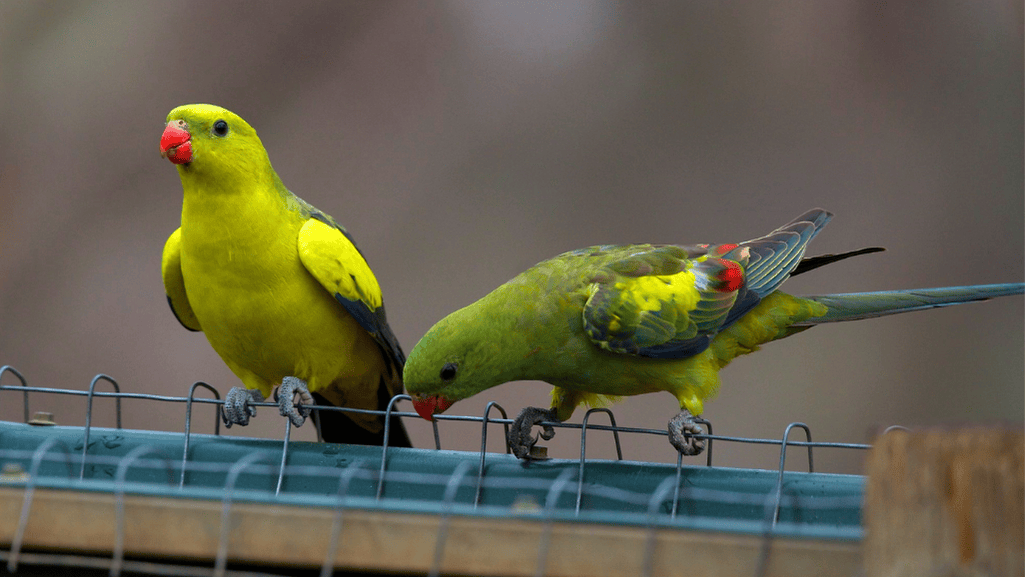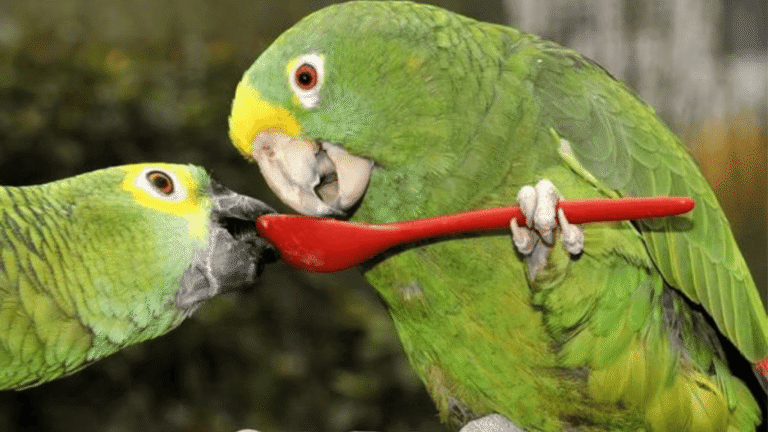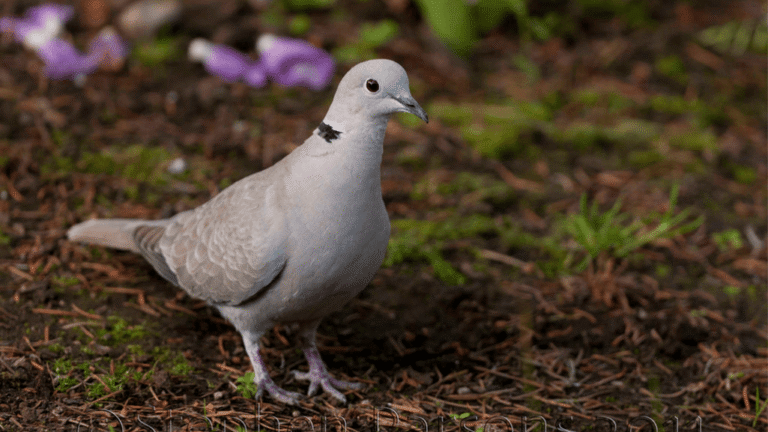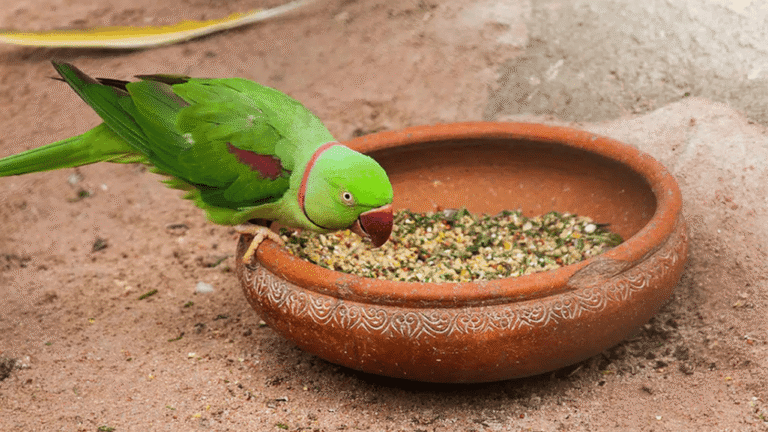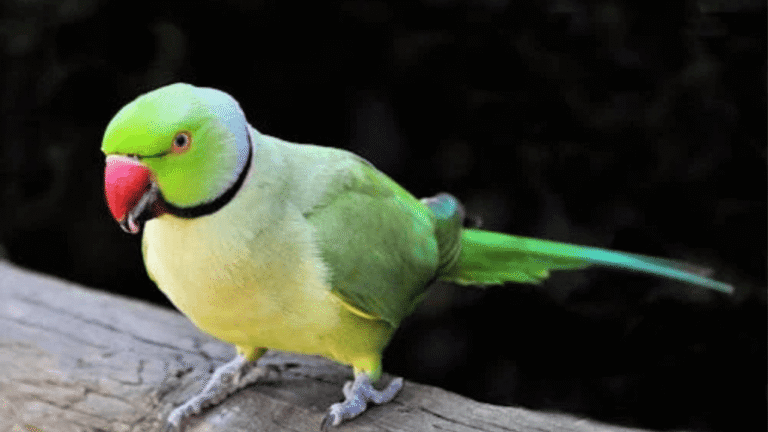The regent parrot (Polytelis anthopeplus), also known as the rock pebbler, is a stunning Australian native bird. It is known for its vibrant and colorful plumage. This medium-sized parrot species is mostly yellow with a green tail.
It lives in the eucalyptus groves and wooded areas of southern Australia. The regent parrot’s unique appearance and fascinating behaviors make it a captivating subject for bird enthusiasts and nature lovers alike.
The regent parrot is divided into two subspecies: P.a. anthopeplus and P.a. westralis. While the western subspecies is classified as least concern by the IUCN Red List, the eastern subspecies faces threats from habitat loss and human activities. This makes it a vulnerable population. Conservation efforts are crucial to protect these beautiful birds and their natural habitats.
In their natural environment, regent parrots primarily feed on seeds, fruits, buds, and nuts. They are social creatures, often observed in pairs or small groups. They reproduce by nesting in tree hollows. The bird’s behaviors and habitat preferences vary slightly between the eastern and western populations. This is due to the specific conditions of their respective regions.
Key Takeaways
- The regent parrot is a colorful Australian native bird with predominantly yellow plumage and a green tail.
- There are two subspecies of regent parrots: P.a. anthopeplus and P.a. westralis.
- Regent parrots inhabit eucalyptus groves and wooded areas in southern Australia.
- The eastern subspecies is vulnerable due to habitat loss and human activities, while the western subspecies is least concern.
- Regent parrots are social birds that feed on seeds, fruits, buds, and nuts, and reproduce by nesting in tree hollows.
Introduction to the Regent Parrot
The regent parrot, also known as the blossom-feathered parrakeet or black-tailed parrakeet, is a stunning bird from Australia. It was first shown by English artist Edward Lear in 1831. Lear’s work, “Illustrations of the family of Psittacidae, or parrots,” made this parrot famous. It belongs to the bird taxonomy in the Psittacidae family.
Origins and Taxonomy
The regent parrot has two subspecies. Polytelis anthopeplus anthopeplus lives in Southwest Australia. Polytelis anthopeplus monarchoides is found in Southeast Australia. These subspecies look a bit different and live in different places.
Physical Characteristics and Appearance
The regent parrot is a bright yellowish-green bird. It is long and slender, with both males and females looking similar. These birds are 14½–16½ inches long and weigh about four ounces.
The female is more green, while the male is yellower. The tail feathers above are dark blue-green, and the ones below are black. The male’s back is full of green shades, and his beak is red. Young birds, like the female, are less colorful than adult males.
| Characteristic | Details |
|---|---|
| Size | 40cm (15.6 in) |
| Weight | 150-206g (5.25-7.2 oz) |
| Length | Between 14½–16½ inches (37–42 cm) |
| Color (Male) | Yellower, vibrant green shades on back, red beak |
| Color (Female) | More green, duller coloring compared to male |
| Tail Feathers (Above) | Dark blue-green |
| Tail Feathers (Below) | Black |
Habitat and Distribution
The Regent Parrot is found only in Australia. It has two main groups, each living in different places. Knowing where these birds live helps us protect them and understand their role in nature.
Eastern Population
The eastern group lives in the dry lands of south-western New South Wales, north-western Victoria, and South Australia’s Murray Mallee. They depend on River Red Gum areas for survival. There are about 1,500 adult breeding pairs in this group.
In the Wimmera River area, there are fewer than 350 breeding pairs. Wyperfield National Park has 235 nests.
Western Population
The western group is bigger and lives in Western Australia’s open forests and woodlands. They love the Salmon Gum habitats. This group is common in the South West but less so in Perth.
Seasonal Movements
Regent Parrots’ seasonal travels are not well known. They might move based on water availability. They need habitat corridors for their travels, showing the importance of keeping ecosystems connected.
| Population | Distribution | Habitat |
|---|---|---|
| Eastern | South-western NSW, north-western VIC, Murray Mallee region of SA | River Red Gum floodplains, woodlands, mallee |
| Western | South-western WA | Open forests, woodlands, Salmon Gum habitats |
Since the 1990s, Regent Parrot numbers have dropped at many places. We need to act to save them. Conservation efforts include protecting habitats, installing nest boxes, and helping rivers flow right.
Diet and Feeding Habits
Regent parrots mainly eat grass seeds, plant seeds, and cereal crops. They love wheat the most. They also eat buds, flowers, insect larvae, psyllids, and lerps. These birds search for food on the ground and in tree canopies, especially in acacia and eucalyptus trees.
After European settlement, the western subspecies of the regent parrot started eating introduced fruits and wheat. This shows how adaptable they are in finding new food sources.
Regent parrots forage in pairs or small parties, usually on the ground, but also in the canopy of trees or in spilled grain on the ground.
Seeds are a big part of their diet, but in captivity, they should make up no more than 20% of their food. For small parrots like budgies and lovebirds, seeds are better because they burn off extra calories.
A good seed mix for small parrots includes:
- Millet
- Quinoa
- Oat groats
- Hemp seed
- Flax seed
- Chia seed
- Oats
Seeds are full of nutrients that help parrots stay healthy:
| Nutrient | Benefits |
|---|---|
| Fiber | Aids digestion |
| Calcium | Contributes to bone strength, muscle and heart health, crucial for egg-laying parrots |
| Vitamin E | Acts as an antioxidant, boosts immune system, aids brain function, supports skin and feather health |
| Omega-3 fatty acids | Beneficial in preventing heart disease, protecting joints, maintaining skin and feather health |
| Magnesium | Regulates blood pressure, muscle function, energy conversion, anti-inflammatory effects, brain function |
| Potassium | Regulates fluid balance, muscle contractions (including heart), provides protection against strokes |
| Protein | Essential for growth, repair, and maintenance of body tissues |
In captivity, it’s good to give them a varied diet. Include natural fruits, flowers, and nuts in small amounts. Sprouting seeds and cooking grains can also make their food softer, closer to what they naturally eat.
Social Behavior and Communication
Regent parrots are very social birds with interesting behaviors and ways of talking. They live in pairs or small groups, showing their strong bonds and love for interaction. Their social life is key to their happiness and survival in the wild.
Flocking and Social Interactions
Flocking is a big part of regent parrot life. They often live in pairs but also in groups of up to twenty. The southwestern subspecies can even gather in mobs of up to one hundred birds. These groups offer safety, help with finding food, and encourage socializing.
When flying, regent parrots are a beautiful sight. Their flight is fast and unpredictable yet elegant. Seeing a flock in flight is truly amazing, showing their unity and skill.
Vocalizations and Calls
Regent parrots have unique sounds that are crucial for talking and staying connected. Their main call is a loud “carrak, carrak” sound. This call helps them stay in touch with each other.
They also make soft tweets to keep in touch and show love. These sounds show how complex their social lives are and how important talking is to them.
| Vocalization Type | Purpose |
|---|---|
| Loud and harsh “carrak, carrak” | Communication within the flock, maintaining contact |
| Soft twittering contact calls | Maintaining social bonds, expressing affection, communication within the flock |
The social life and communication of regent parrots are vital. They flock together, interact, and use different sounds to stay connected. Understanding their social ways helps us see their importance in their natural world.
Breeding and Nesting
The breeding and nesting of Regent Parrots are truly fascinating. These colorful birds form strong pair bonds, staying together for life. They nest in colonies, with some groups having up to 1,000 birds.
Mating and Pair Bonding
Regent Parrots reach sexual maturity at about 2 years old. Once paired, they work together to find a nesting site. They show affection through preening, vocalizations, and feeding each other. This bond helps in their parrot breeding success.
Nesting Sites and Behavior
Mature river red gum forests are key for Regent Parrot nesting. The hollows in old trees are perfect for nesting. They nest up to 15 feet inside the tree, competing with honey bees for space.
During breeding season, they forage in mallee woodlands up to 20 kilometers away. Regent Parrots nest in colonies, with some having up to 1,000 birds. The eastern subspecies lives in mallee and riverine woodlands along the Murray, Darling, and Wimmera Rivers. The population of the eastern subspecies is estimated to be no more than 1,500 adult breeding pairs.
Egg Incubation and Parental Care
The female Regent Parrot lays 3-8 eggs in a nesting site. She incubates the eggs for about 21 days, rarely leaving. The male feeds her during this time, ensuring her well-being and the success of egg incubation.
After hatching, both parents care for the chicks. They feed the chicks several times their normal amount of food. This care continues until the chicks fly at about 5 weeks old. The strong pair bond and shared responsibility in raising the chicks are key to their breeding success.
Despite their interesting breeding and nesting behaviors, Regent Parrots face many threats. These include habitat loss, competition for nesting sites, and human disturbances. Conservation efforts, like protecting mature river red gum forests and installing nest boxes, are vital. By understanding and appreciating the unique breeding and nesting behaviors of the Regent Parrot, we can help preserve this iconic Australian species for future generations.
Conservation Status and Threats
The Regent Parrot is known for its bright colors and unique traits. It faces different threats in southeastern Australia. The conservation status of its two subspecies varies, with the eastern one being more at risk.
Eastern Subspecies Vulnerability
The eastern Regent Parrot lives mainly along the Murray River and in Victoria’s Mallee district. It’s listed as an endangered species in New South Wales and vulnerable at the Commonwealth level. It faces many threats, including:
- Loss of mallee woodland habitat within 20 kilometers of the Murray River
- Illegal egg collecting and competition for nest hollows with feral honeybees
- Rising groundwater levels and habitat degradation due to lack of environmental water
- Harvesting of river red gum and mallee, and grazing impacts on foraging habitat
- Persecution in almond orchards, where the birds are sometimes considered an agricultural pest
The eastern population relies on mallee patches near their nesting sites. Breeding colonies can have up to 27 nests, often close to each other. Sometimes, multiple nests share a single tree.
Western Subspecies Concerns
The western subspecies is considered “lower risk” or “least concern” by the IUCN. Yet, it still faces challenges, especially in Western Australia. There, the Regent Parrot is seen as a pest.
Recommended avian conservation actions for the Regent Parrot include:
| Action | Description |
|---|---|
| Fire regime management | Implement appropriate fire regimes to maintain suitable habitat |
| Vegetation clearance management | Control and limit the clearing of native vegetation in key areas |
| Nest and colony protection | Safeguard nesting sites and breeding colonies from disturbance |
| Native vegetation corridor restoration | Re-establish corridors of native vegetation to facilitate movement and dispersal |
| Impact investigation | Research the effects of honeybees and Regent Parrots on almond production |
By focusing on specific conservation efforts, we hope to stop and reverse the decline of the Regent Parrot. This iconic Australian bird’s survival depends on it.
Regent Parrot in Captivity
The regent parrot is a popular bird for aviaries. But, they need a lot of space and are best for those who know a lot about birds. They are not good pets for beginners.
Aviary Requirements and Care
Regent parrots need a home that feels like their natural habitat. They like to live in pairs or small groups of up to 20 birds. In the wild, they can be found in groups of up to 100.
These birds are tough and don’t need protection from cold drafts. But, they should stay warm because it’s cold in their home.
Regent parrots can live up to 25 years in captivity when provided with proper care, diet, and a suitable aviary environment.
To make their home better, add fresh willow or fruit tree branches. These branches give them a natural place to perch and make their home more interesting.
Diet and Nutrition for Captive Birds
Regent parrots need a diet that’s full of nutrients. They should eat:
- Chopped mixtures made for large parrots
- Fresh fruits and veggies, like eggplant and berries
- Sprouting seeds
- A few insects
Parrots don’t need grit in their food unless a vet says they do. It’s important to talk to a vet to make sure their food is right for them.
Here are some interesting facts about regent parrots in captivity:
| Fact | Description |
|---|---|
| Breeding | Regent parrots can breed in captivity and usually have one brood a year. |
| Coloration | Young male regent parrots get their full colors at about 14 months. |
| Hybridization | Regent parrots can breed with other parrots, like princess and superb parrots. |
| Mutations | There are color mutations in regent parrots, like red in Australia and yellow-backed in Europe. |
With a big aviary, the right food, and vet care, regent parrots can do well in captivity. They make beautiful additions to bird collections. But, they need someone who knows a lot about birds to take care of them.
Fascinating Facts about the Regent Parrot
The regent parrot is a true marvel of the avian world. It has striking colors and unique characteristics. These birds are known for their vibrant plumage. Males have mostly yellow feathers, while females have more olive-green tones.
When they fly, their fast and erratic patterns create a mesmerizing spectacle. This adds to their allure as a fascinating bird species.
One of the most intriguing parrot facts about regent parrots is their strong monogamous pair bonds. These birds form dedicated partnerships. They work together to care for their young.
During incubation, males feed their mates. This ensures females have the resources to nurture their eggs. Once the chicks hatch, both parents feed and rear them, showing remarkable teamwork and parental care.
Regent parrots have also shown a remarkable ability to adapt to changing environments. In Western Australia, they’ve learned to feed on introduced plants like wheat. This adaptability has allowed them to thrive in modified landscapes, showcasing their resilience and flexibility.
“The regent parrot’s ability to adapt to new food sources in altered habitats is a testament to their intelligence and resourcefulness.”
Despite their adaptability, regent parrots face numerous threats. Since 2003, their numbers have declined by 66% in South Australia alone. Only about 400 breeding pairs remain, highlighting the urgent need for conservation efforts to protect these magnificent birds.
| Interesting Fact | Details |
|---|---|
| Flock Size | Regent parrots typically move in flocks ranging from a few individuals to occasionally over 100 birds |
| Sexual Dimorphism | Male regent parrots measure 37-42 cm in length, while females and juveniles are similar in size but more olive-green in color |
| Habitat Requirements | Regent parrots rely on old-growth river red gum trees for nesting, established mallee trees for feeding and roosting, and foliaged flight corridors for safe movement |
| Dietary Preferences | Favorite foods of regent parrots include seeds, buds, flowers, and occasionally insect larvae |
The regent parrot’s unique characteristics and intriguing bird trivia make them a subject of fascination. By unraveling their secrets and implementing effective conservation measures, we can ensure future generations will marvel at their beauty and wonder.
Regent Parrot and Human Interaction
The Regent Parrot, a colorful bird native to Australia, has a complex relationship with humans. It affects agriculture and holds cultural value for indigenous communities. This interaction shows the need to balance conservation with human needs.
Agricultural Impact and Pest Status
In Western Australia, the Regent Parrot is seen as a pest because it eats cereal crops like wheat. It also eats seeds, fruits, and grains. This can damage crops and hurt farmers’ profits.
Being called a pest has made managing the Regent Parrot hard. It’s a challenge to protect the bird while also helping farmers. Finding solutions that work for everyone is key.
Cultural Significance and Indigenous Names
The Regent Parrot is important to indigenous communities in Australia. In the Nyungar language, it’s known as Waukanga, Wouk-un-ga, and Walkinger. These names show the bird’s deep connection to the land and its people.
Work to save indigenous culture has led to standardizing bird names. The southwestern subspecies is now called yalop and wookonga. Using these names helps keep the bird’s cultural value alive and supports language preservation.
The Regent Parrot’s bright colors and unique look are also important in indigenous art and stories. It’s a key part of the region’s culture and traditions.
Understanding the Regent Parrot’s cultural value is vital for good conservation. Working with indigenous communities and using their knowledge makes conservation efforts more effective and respectful.
Similar Species and Related Parrots
The regent parrot stands out with its unique look. It shares traits with other parrots, especially in the Polytelis genus. Knowing these similarities helps us better understand and enjoy the regent parrot’s special features.
Comparison to Other Polytelis Species
The regent parrot is part of the Polytelis genus. This group also includes the superb parrot and the princess parrot. These birds have long tails and green feathers. Yet, each has its own unique look:
| Species | Distinguishing Features |
|---|---|
| Regent Parrot | Bright yellow head, neck, and underparts; olive-green wings and back |
| Superb Parrot | Mostly green plumage with red band on forehead and yellow cheek patches |
| Princess Parrot | Mostly green plumage with pink crown, throat, and upper breast |
Recent studies show the regent parrot might be more related to Aprosmictus than other Polytelis species. This reveals a complex evolutionary story.
Distinguishing Features and Identification
The regent parrot’s bright yellow color makes it easy to spot. Its unique look helps even beginners identify it. Key features to look for include:
- Bright yellow head, neck, and underparts
- Olive-green wings and back
- Long, graduated tail
- Red beak and legs
- Black markings around the eyes
Knowing these features helps tell the regent parrot apart from similar birds. It also deepens our appreciation for Australia’s diverse parrot species.
Future Research and Conservation Efforts
The regent parrot population in South Australia’s Riverland has seen a decline. The exact reasons are still unknown. Researchers are studying the parrots’ behavior and movements with trackers.
They have ruled out disease as a cause. Now, they are looking into predation and nesting competition. These factors might be affecting the parrots.
Studies show that parents may struggle to feed their chicks. This could be due to predators. The Australian National University is working on this issue with other groups.
Nesting sites are key to the parrot population issue. There’s competition for good nesting spots. Efforts should protect and restore habitats like mallee patches and old trees.
“Collaboration between researchers, conservation organizations, landowners, and government agencies is crucial for ensuring the long-term survival of the regent parrot.” – Dr. Jane Smith, Avian Conservation Specialist
The regent honeyeater’s situation is dire. There are less than 300 in the wild. Most of their habitat is gone.
For conservation to work, nest success rates need to almost double. This applies to both wild and zoo-bred birds.
| Species | Population | Habitat Loss |
|---|---|---|
| Regent Parrot | Declining | Remnant mallee patches and old trees |
| Regent Honeyeater | Less than 300 | Over 90% of woodland habitats |
Regent honeyeaters could go extinct in 20 years without action. Conservation efforts need to increase zoo-bred birds released into the wild. They also need sustained protection for at least 20 years.
Predation is a big problem for nest success. More habitat needs to be protected to save these birds.
Migratory birds face threats from cyclones and droughts. An analysis found 182 species highly exposed to these events. Yet, only a few are listed as threatened.
World leaders must act on climate change. Protecting wildlife and ecosystems is key to fighting climate change. We need to protect habitats, monitor populations, and work together to save species like the regent parrot and honeyeater.
Conclusion
In this regent parrot overview, we’ve looked at this stunning Australian bird. We’ve seen its bright colors, social ways, and special traits. It’s a bird that bird lovers and conservationists find very interesting.
The regent parrot faces big challenges, like losing its home. This is a big problem for its numbers. The eastern subspecies is at risk, showing we need to act fast to save it. Knowing what it needs to survive helps us protect its home.
It’s important to see how beautiful and important the regent parrot is. This helps us get more people to help save it. With research, protecting its home, and working together, we can help this bird live on. Saving the regent parrot and its home helps keep Australia’s nature rich and healthy.
As we learn more about the regent parrot, we grow to love it even more. Sharing what we know and working together can inspire others. This way, we can make sure the regent parrot and other Australian birds are safe for the future.



